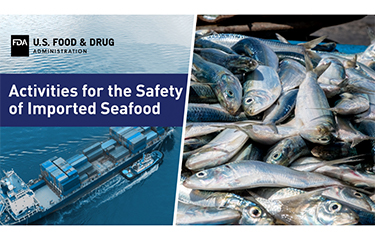The U.S. Food and Drug Administration has released a report outlining how it plans to continue keeping the country’s seafood imports safe.
The report, "Activities for the Safety of Imported Seafood," released in late February 2023, explains how the FDA is building upon the FDA Food Safety Modernization Act and the FDA Strategy for the Safety of Imported Food to accomplish its goals for imported seafood. In its report, the FDA acknowledged that the seafood supply chain one of the most-complicated it deals with. Further complicating its job is the fact that a vast majority of the seafood consumed in the U.S. is imported.
“Today the United States imports seafood from more than 144 countries or territories and approximately 10,202 exporting food facilities, plus aquaculture farms,” the report states.
The FDA outlined four main goals for its oversight. The first goal is to make sure that seafood offered for import meets U.S. food safety requirements. The FDA plans to accomplish the goal by optimizing inspections, ensuring processors and importers are meeting standards, and leveraging the oversight efforts of foreign regulators.
“To ensure that imported seafood meets U.S. food safety requirements at the time it is offered for import, FDA focuses on preventing unsafe product from reaching our border by using verification, enhanced compliance, and increased data and information-sharing,” the FDA said.
The second goal is enhancing the FDA’s border security and inspections to intercept any unsafe seafood coming into the U.S. Part of those efforts includes the utilization of new technology, such as artificial intelligence, to optimize inspections and improve the FDA’s ability to spot potential problems.
Currently, the FDA uses what it calls Predictive Risk-Based Evaluation for Dynamic Import Compliance Targeting – or “PREDICT” – in screening seafood. In 2019, the FDA launched a pilot project to enhance PREDICT using AI and machines learning.
“Efforts continue to improve and expand the application of AI/ML to imported seafood,” the FDA said.
The third goal for the FDA, it said, is rapid “and effective” response in the event unsafe imported seafood manages to make its way into the country.
“Actions the FDA is taking include the efforts of the Coordinated Outbreak Response and Evaluation Network, the Foodborne Outbreak Response Improvement Plan, the Prevention Strategies, and the Food Traceability Final Rule and communications with states utilizing networks such as the Interstate Shellfish Sanitation Program,” the FDA said in a release.
The final goal is improving the effectiveness and efficiency of the FDA’s seafood import program. It said the administration is creating a “comprehensive global inventory” of seafood facilities – including processing facilities and aquaculture farms – and creating “new metrics to measure success.”
The report, the FDA said, represents its efforts to continuously improve the safety of the seafood supply chain in the U.S.
“The global food system is constantly evolving, including the production and delivery of imported seafood,” an FDA release said. “The FDA is also evolving, implementing a new vision for the foods program that will help the agency to keep pace with the times, supporting improvement and innovation that will benefit consumers while helping to ensure that these advances are producing safe foods for U.S. consumers and around the world.”
National Fisheries Institute President and CEO Lisa Wallenda Picard, representing the seafood industry, said the report shows that the FDA “understands food safety needs are ever evolving” and that the new report highlights its efforts to continue ensuring imported seafood is safe.
“FDA’s work doesn’t simply rely on optimized inspections, it strengthens surveillance, improves predictive analytics, and even includes a pilot program using artificial intelligence,” she wrote. “In fact, the bulk of the agency’s work is focused on prevention. Imported seafood is required to meet the same safety standards as seafood produced in this country and this work demonstrates how that is achieved.”
Photo courtesy of the U.S. Food and Drug Administration







